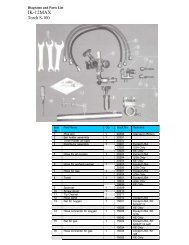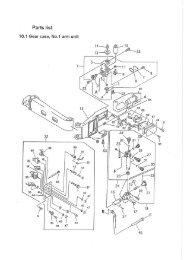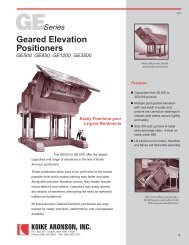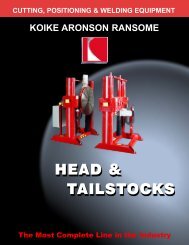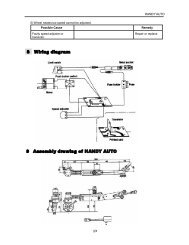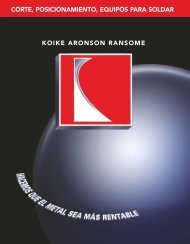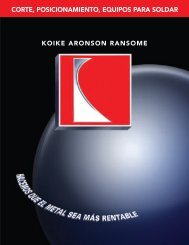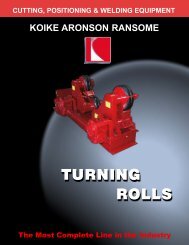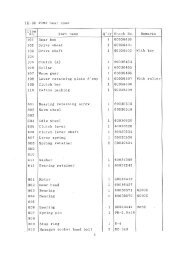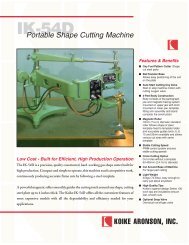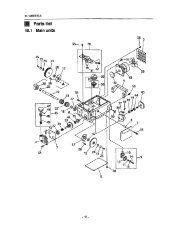Elevating Headstock/Tailstock Positioners Powered Elevation keeps work close to floor for each loading, adjusts to convenient welding height and lift full load for swing clearance height, safely. ARONSON STYLE PATENTED “GEARED ELEVATION” HEADSTOCK/TAILSTOCK POSITIONERS Geared Elevation has posts with rack teeth and chassis with lift pinions. All pinions are geared together and must run together. The chassis is always level and steady. With loading down on the front racks and a lesser reactionary force up on the rear racks it is impossible for all the teeth to wear out and fail simultaneously, regardless of length of service or magnitude of the load. If the heavier loaded front teeth wear out or break, the chassis will jam and will not crash down as the strong teeth at the rear are holding safely. RANSOME STYLE “BALL SCREW ELEVATION” HEADSTOCK/TAILSTOCK POSITIONERS The “Ball Screw” Elevation design makes maximum use of proven commercially available components, both in the elevation and guidance systems. Elevation is by means of commercial Ball screw jacks for high duty cycle operation, driven by a worm/wormgear arrangement. Elevation uses two of these screw jacks for redundancy, coupled together and driven by a common motor. Guidance is by means of wide, large diameter cam followers bearing on flat guide-ways, or Linear Bearings and ways depending on size. Guidance is provided on front and back of two columns that rigidly support the cantilevered load. In the case of Headstock / Tailstock Elevating Positioners, the synchronization between Head and Tailstock utilizes AC Variable Frequency drives that provide dynamic synchronization during the elevation cycle, as well as absolute mechanical resynchronization at full stroke, at either top or bottom limits. Periodic mechanical resynchronization at end of travel may be required. 20
Comprehensive Load Capacity Table Elevating Headstock/Tailstock Positioners Model Load off Rotation CG Lbs. @ 6” Rotation Torque In/Lbs. Max Load Between Head & Tail (Lbs.) CG@ 6” CG@ 12” HS2VF 2,500 30,000 — 2,500 2,500 1,100 850 700 600 500 450 400 350 325 300 TS2 2,500 — — 2,500 2,500 1,100 850 700 600 500 450 400 350 325 300 HTS5VF—GE 5,000 30,000 5,000 2H/2T-PE 5,000 30,000 5,000 3H/3.5T-PE 6,000 36,000 6,000 HS4VF 4,500 54,000 — 4,500 4,500 2,000 1,550 1,300 1,100 950 800 750 650 600 550 TSVF 4,500 — — 4,500 4,500 2,000 1,550 1,300 1,100 950 800 750 650 600 550 HTS9VF—GE 9,000 54,000 9,000 3.5H/3.5T-PE 9,000 54,000 9,000 HS6VF 6,000 72,000 — 6,000 6,000 4,400 3,450 2,850 2,400 2,100 1,850 1,650 1,500 1,400 1,250 TS6 6,000 — — 6,000 6,000 4,400 3,450 2,850 2,400 2,100 1,850 1,650 1,500 1,400 1,250 HTS12VF—GE 12,000 72,000 12,000 4H/4T-PE 12,000 72,000 12,000 HS10VF 10,000 120,000 — 10,000 10,000 7,350 5,850 4,850 4,100 3,600 3,200 2,850 2,600 2,350 2,200 TS10 10,000 — — 10,000 10,000 7,350 5,850 4,850 4,100 3,600 3,200 2,850 2,600 2,350 2,200 HTS20VF—GE 20,000 120,000 20,000 5H/5T-PE 20,000 120,000 20,000 HS16VF 16,000 192,000 — 16,000 16,000 12,000 9,600 8,000 6,850 6,000 5,300 4,800 4,350 4,000 3,850 TS16 16,000 — — 16,000 16,000 12,000 9,600 8,000 6,850 6,000 5,300 4,800 4,350 4,000 3,850 HTS32VF—GE 32,000 192,000 32,000 6H/6T-PE 32,000 192,000 32,000 HS20VF 20,000 240,000 — 20,000 20,000 15,000 12,000 10,000 8,550 7,500 6,650 6,000 5,450 5,000 4,600 TS20VF 20,000 — — 20,000 20,000 15,000 12,000 10,000 8,550 7,500 6,650 6,000 5,450 5,000 4,600 HTS20VF – GE 40,000 240,000 40,000 HS25VF 25,000 300,000 — 25,000 25,000 18,900 15,200 12,750 10,950 9,600 8,550 7,700 7,000 6,400 5,950 TS25 25,000 — — 25,000 25,000 18,900 15,200 12,750 10,950 9,600 8,550 7,700 7,000 6,400 5,950 HTS50VF—GE 50,000 300,000 50,000 7H/7T-PE 50,000 300,000 50,000 HS30VF 30,000 400,000 — 30,000 30,000 22,850 18,450 15,500 13,350 12,200 10,450 9,400 8,550 7,850 7,250 TS30 30,000 — — 30,000 30,000 22,850 18,450 15,500 13,350 12,200 10,450 9,400 8,550 7,850 7,250 HTS60VF—GE 60,000 400,000 60,000 8H/8T-PE 80,000 480,000 80,000 HS45VF 45,000 540,000 — 45,000 45,000 34,400 27,850 23,400 20,150 17,700 15,800 14,250 13,000 11,900 11,000 TS45 45,000 — — 45,000 45,000 34,400 27,850 23,400 20,150 17,700 15,800 14,250 13,000 11,900 11,000 HTS90VF—GE 90,000 540,000 90,000 10H/10T-PE 100,000 600,000 100,000 HS80 80,000 960,000 — 80,000 80,000 61,150 49,500 41,600 35,850 31,500 28,100 25,350 23,100 21,200 19,600 TS80 80,000 — — 80,000 80,000 61,150 49,500 41,600 35,850 31,500 28,100 25,350 23,100 21,200 19,600 HTS160VF-GE 160,000 960,000 160,000 16H/16T-PE 160,000 960,000 160,000 HS120VF 120,000 1,440,000 — 120,000 120,000 92,000 75,000 83,000 54,000 48,000 42,000 38,000 35,000 32,000 30,000 TS120 120,000 — — 120,000 120,000 92,000 75,000 83,000 54,000 48,000 42,000 38,000 35,000 32,000 30,000 HTS240VF-GE 240,000 1,440,000 240,000 21 CG@ 18” CG@ 24” CG@ 30” CG@ 36” CG@ 42” CG@ 48” CG@ 54” CG@ 60” LOAD EVENLY DISTRIBUTED BETWEEN HEAD & TAILSTOCK LOAD EVENLY DISTRIBUTED BETWEEN HEAD & TAILSTOCK LOAD EVENLY DISTRIBUTED BETWEEN HEAD & TAILSTOCK LOAD EVENLY DISTRIBUTED BETWEEN HEAD & TAILSTOCK LOAD EVENLY DISTRIBUTED BETWEEN HEAD & TAILSTOCK LOAD EVENLY DISTRIBUTED BETWEEN HEAD & TAILSTOCK LOAD EVENLY DISTRIBUTED BETWEEN HEAD & TAILSTOCK LOAD EVENLY DISTRIBUTED BETWEEN HEAD & TAILSTOCK LOAD EVENLY DISTRIBUTED BETWEEN HEAD & TAILSTOCK LOAD EVENLY DISTRIBUTED BETWEEN HEAD & TAILSTOCK LOAD EVENLY DISTRIBUTED BETWEEN HEAD & TAILSTOCK LOAD EVENLY DISTRIBUTED BETWEEN HEAD & TAILSTOCK LOAD EVENLY DISTRIBUTED BETWEEN HEAD & TAILSTOCK LOAD EVENLY DISTRIBUTED BETWEEN HEAD & TAILSTOCK CG@ 66” CG @ 72”



